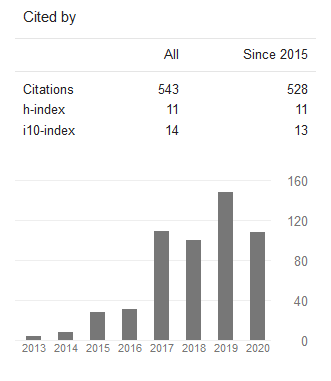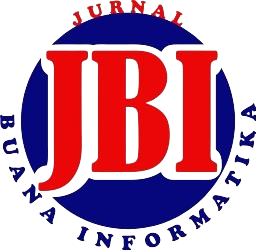Klasterisasi Puskesmas dengan K-Means Berdasarkan Data Kualitas Kesehatan Keluarga dan Gizi Masyarakat
DOI:
https://doi.org/10.24002/jbi.v14i01.7105Keywords:
data mining, K-Means, klasterisasi, Angka Kematian Ibu, Angka Kematian Bayi, prevalensi stunting, data mining, K-Means, clustering, Maternal Mortality Rate, Infant Mortality Rate, the prevalence of stuntingAbstract
One of the fundamental principles followed by the Jember Health Office for decision-making is data. Data plays a crucial role in the decision-making process. Raw data is more difficult to interpret and needs to be analyzed. Clustering is one of the techniques used for analysis. This study discusses using K-Means to cluster Public Health Center data based on AKI, AKB, and stunting prevalence. The data is processed by reducing dimensions and normalizing them. The clustering process is performed using the K-Means method, where the maximum k-value is obtained by calculating WCSS. The clustering process results in three clusters of Public Health Centers in the Jember Regency. These clusters can serve as a reference for the Jember Health Office to formulate family health and community nutrition quality policies.
Keywords: data mining, K-Means, clustering, Maternal Mortality Rate, Infant Mortality Rate, the prevalence of stunting
Salah satu dasar pengambilan kebijakan oleh Dinas Kesehatan Jember adalah data. Data memiliki peran dalam proses pengambilan keputusan. Data mentah yang didapatkan lebih sulit untuk diinterpretasikan sehingga diperlukan analisis terhadap data tesebut. Salah satu analisis yang dapat digunakan adalah teknik klasterisasi. Pada
penelitian ini akan dibahas penggunaan K-Means untuk klasterisasi data puskesmas berdasarkan AKI, AKB, dan prevalensi stunting. Data diproses dengan melakukan reduksi dimensi dan normalisasi. Proses klasterisasi dilakukan dengan metode K-Means dimana nilai k maksimal diperoleh dengan menghitung WCSS. Adapun hasil proses klasterisasi didapatkan tiga kelompok klaster puskesmas yang terdapat di Kabupaten Jember. Hasil klasterisasi dapat digunakan sebagai referensi Dinas Kesehatan Jember dalam mengambil kebijakan terkait kualitas kesehatan keluarga dan gizi masyarakat
Kata Kunci: data mining, K-Means, klasterisasi, Angka Kematian Ibu, Angka Kematian Bayi, prevalensi stunting
References
L. Hong, M. Luo, R. Wang, P. Lu, W. Lu, and L. Lu, “Big Data in Health Care: Applications and Challenges,” Data Inf. Manag., vol. 2, no. 3, pp. 175–197, 2018, doi: 10.2478/dim-2018-0014.
M. Alloghani, D. Al-Jumeily, J. Mustafina, A. Hussain, and A. J. Aljaaf, “A Systematic Review on Supervised and Unsupervised Machine Learning Algorithms for Data Science,” in Supervised and Unsupervised Learning for Data Science, M. W. Berry, A. Mohamed, and B. W. Yap, Eds. Cham: Springer International Publishing, 2020, pp. 3–21. doi: 10.1007/978-3-030-22475-2_1.
M. Bramer, Principles of Data Mining, vol. 30, no. 7. London: Springer London, 2020. doi: 10.1007/978-1-4471-7493-6.
D. Mining, B. Cancer, and B. Cancer, “Application of Data Mining Techniques to Predict Breast Cancer,” Procedia Comput. Sci., vol. 163, pp. 11–18, 2019, doi: 10.1016/j.procs.2019.12.080.
F. G. Woldemichael and S. Menaria, “Prediction of Diabetes Using Data Mining Techniques,” Proc. 2nd Int. Conf. Trends Electron. Informatics, ICOEI 2018, no. Icoei, pp. 414–418, 2018, doi: 10.1109/ICOEI.2018.8553959.
M. Singh, “Classification system via data mining algorithm: New tool to diagnose Alzheimer’s disease,” J. Neurol. Sci., vol. 405, no. 2019, pp. 161–162, 2019, doi: 10.1016/j.jns.2019.10.1084.
M. M. Ali, B. K. Paul, K. Ahmed, F. M. Bui, J. M. W. Quinn, and M. A. Moni, “Heart disease prediction using supervised machine learning algorithms: Performance analysis and comparison,” Comput. Biol. Med., vol. 136, no. July, p. 104672, 2021, doi: 10.1016/j.compbiomed.2021.104672.
M. L. Kolling et al., “Data mining in healthcare: Applying strategic intelligence techniques to depict 25 years of research development,” Int. J. Environ. Res. Public Health, vol. 18, no.6, pp. 1–21, 2021, doi: 10.3390/ijerph18063099.
BPS (Badan Pusat Statistik), “Kabupaten Jember dalam Angka 2021 (Jember Regency in Figures),” pp. 1–630, 2020.
Dinkes Jember, “Profil Kesehatan Kabupaten Jember 2020,” Profil Kesehat. Kabupaten Jember 2020, pp. 1–12, 2020.
K. Jember, “Rencana Strategis Dinas Kesehatan Kabupaten Jember Tahun 2021 – 2026,” Jember, 2019.
K. Buse, N. Mays, and G. Walt, Making Health Policy, Second Edi. New York, NY: McGraw-Hill, 2012. doi: 10.1163/9789004333109.
M. Madjido, A. Espressivo, A. W. Maula, A. Fuad, and M. Hasanbasri, “Health information system research situation in Indonesia: A bibliometric analysis,” Procedia Comput. Sci., vol. 161, pp. 781–787, 2019, doi: 10.1016/j.procs.2019.11.183.
S. A. Abbas, A. Aslam, A. U. Rehman, W. A. Abbasi, S. Arif, and S. Z. H. Kazmi, “K-Means and K-Medoids: Cluster Analysis on Birth Data Collected in City Muzaffarabad, Kashmir,” IEEE Access, vol. 8, pp. 151847–151855, 2020, doi: 10.1109/ACCESS.2020.3014021.
D. T. A. Luong and V. Chandola, “A K-Means Approach to Clustering Disease Progressions,” Proc. - 2017 IEEE Int. Conf. Healthc. Informatics, ICHI 2017, pp. 268–274, 2017, doi: 10.1109/ICHI.2017.18.
M. B. Gesicho, M. C. Were, and A. Babic, “Evaluating performance of health care facilities at meeting HIV-indicator reporting requirements in Kenya: an application of K-means clustering algorithm,” BMC Med. Inform. Decis. Mak., vol. 21, no. 1, pp. 1–18, 2021, doi:10.1186/s12911-020-01367-9.
S. Cinaroglu, “Integrated k-means clustering with data envelopment analysis of public hospital efficiency.,” Health Care Manag. Sci., vol. 23, no. 3, pp. 325–338, Sep. 2020, doi:10.1007/s10729-019-09491-3.
H. Santoso, H. Magdalena, H. Wardhana, and I. Artikel, “Aplikasi Dynamic Cluster pada KMeans Berbasis Web untuk Klasifikasi Data Industri Rumahan Web-based Application of Dynamic Cluster on K-Means for Classification of Home Industry Data,” J. Manaj. , Tek.Inform. dan Rekayasa Komput., vol. 21, no. 3, pp. 541–554, 2022, doi: 10.30812/matrik.v21i3.1720.
A. Saxena et al., “A review of clustering techniques and developments,” Neurocomputing, vol. 267, pp. 664–681, 2017, doi: 10.1016/j.neucom.2017.06.053.
I. H. Witten, Data Mining- Practical Machine Learning Tools and Techniques, Fourth Edi. Cambridge: Morgan Kaufman, 2017.
P. Zong, J. Jiang, and J. Qin, “Study of high-dimensional data analysis based on clustering algorithm,” 15th Int. Conf. Comput. Sci. Educ. ICCSE 2020, no. Iccse, pp. 638–641, 2020, doi: 10.1109/ICCSE49874.2020.9201656.
B. Subramanian, A. Paul, J. Kim, and K. W. A. Chee, “Metrics Space and Norm: Taxonomy to Distance Metrics,” Sci. Program., vol. 2022, 2022, doi: 10.1155/2022/1911345.
Downloads
Published
Issue
Section
License

This work is licensed under a Creative Commons Attribution-ShareAlike 4.0 International License.
Copyright of this journal is assigned to Jurnal Buana Informatika as the journal publisher by the knowledge of author, whilst the moral right of the publication belongs to author. Every printed and electronic publications are open access for educational purposes, research, and library. The editorial board is not responsible for copyright violation to the other than them aims mentioned before. The reproduction of any part of this journal (printed or online) will be allowed only with a written permission from Jurnal Buana Informatika.
This work is licensed under a Creative Commons Attribution-ShareAlike 4.0 International License.










